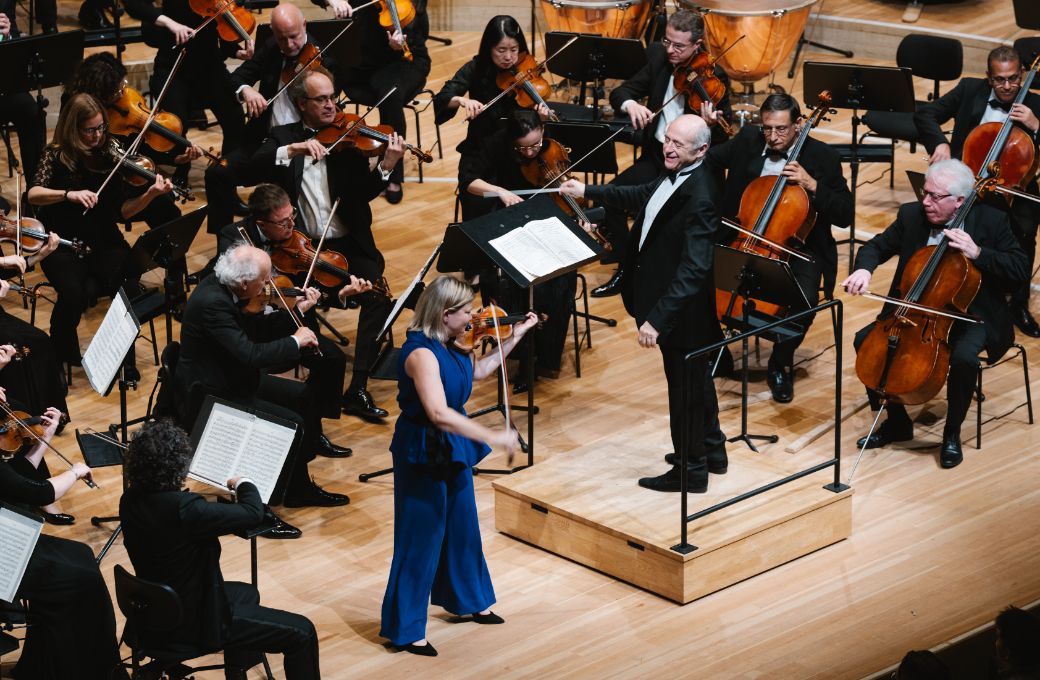As the audience entered the Elbphilharmonie, the platform was already crowded with instruments – four harps, extra percussion, piano, celesta and even an organ console among an expanded brass and woodwind section. It looked like a full scale opera house pit transported onto the stage, hinting that the second half would unleash the full symphonic and theatrical force of Richard Strauss.

Yet that visual anticipation lent extra weight and focus to what came first: Beethoven’s Violin Concerto. Just after the opening passages, Alina Ibragimova started to play seamlessly with the orchestra during the tutti passages before the traditional solo entry. She moved within the ensemble as an equal, her tone focused and expressive, occasionally deliberately raw at the edges, adding a tactile immediacy to the sound. The Budapest Festival Orchestra responded with striking rhythmic vitality and wide-ranging dynamic contrasts, while Iván Fischer’s tempo maintained a natural forward thrust.
The development section’s quiet passages were particularly arresting: Ibragimova’s sound withdrew to a near-whisper, dark and delicate, so that the return of the theme blazed with renewed brightness. Her own cadenza was a highlight. It unfolded as a dialogue with the timpani, opening an unexpected sense of spatial depth and improvising tension, subtly echoing the opening gestures of the first movement. The Larghetto followed with luminous simplicity, almost pastoral in imagery, its sweetness offset by crisp articulation. A brief, imaginative cadenza hinted at the finale’s rhythmic motif, linking the movements organically. In the Rondo, Fischer pushed the tempo slightly faster than usual, producing an exhilarating effect without hurry; the music unfolded in one continuous gesture, full of impulse, energy and joyous momentum.
After the interval, Strauss’ biblical ballet Josephs Legende filled the hall with cinematic sound and colour. The music’s narrative – Joseph’s moral steadfastness amid the sensual temptation of Potiphar’s wife – was rendered through sound alone. The orchestra conjured the various dance sequences with remarkable clarity: the Procession and Dance of the Women shimmered with asymmetrical rhythms that led naturally into a seductive waltz, while the following Dance of the Turkish Boxers was marked by aggressive timpani and bold, masculine orchestral gestures.
Central to the ballet is the leitmotif drawn from a Rose-Picking Round Dance from Kythere. Its delicate orchestration creates an almost ethereal effect. This motif recurs throughout, its archaic, mystic quality giving a sense of innocence and ritual, balancing the more sensuous and dramatic material. Potiphar’s wife is characterised by dark, brooding brass and minor-mode sonorities, her presence immediately audible in the ominous textures. Other tender episodes, such as Joseph’s encounters with Potiphar’s wife or his playful leaps in dance, where flutes, harps and clarinets reflect the lightness and agility of his steps.
Although the audience’s eyes were riveted on Hofmannsthal’s projected text, the intensity of the music and performance made it feel as if they were witnessing a full-scale cinematic spectacle unfolding on stage. This compact 70-minute miniature – by Strauss’s standards of course – deserves far more frequent performances.
For this programme, Fischer exploited the Elbphilharmonie’s acoustics to the fullest, projecting every colour and texture with remarkable clarity. Like a master driver at the wheel of a luxury sports car, he knew exactly what his orchestra could do, harnessing its full power with effortless control. The result was a concentrated, exhilarating experience, reminding the audience that great music thrives when performed with imagination, risk and a pulse that never settles into comfort.


